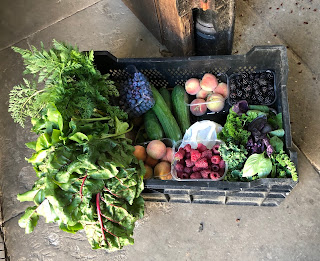June at Norton Conyers began with a fanfare of colour. Having been ‘split’ two years ago, expectations were high for the irises. And they bloomed in florid abundance.
The June British weather was kinder on the garden this year.
Mid June 2018 marked the beginning of a long summer heatwave; it will last long in the memory for many. However, so far in summer 2019, the weather has struck a kind, nurturing balance – a mix of coolness and warmth; clarity and cloud; sunshine and rain. Unremarkable, yet generally pleasant weather by all counts.
Whilst mowing was brought to a halt for a number of weeks last year due to the dry ground and slow grass growth, so far this year the lawnmower has not been out of action. A weekly trim has been necessary to keep the lush, verdant grass tidy and neat. So, it’s taken up much of my time this month!
But, as the summer months progress, the fruit and vegetable gardens demand increasing attention. With potatoes, onions and peas among the vegetables already planted at the beginning of June, the rest of the vegetable plot needed preparing – earth weeding and turning.
 |
| Preparing the vegetable borders |
And with the strawberry plants beginning to bear fruit, nets were placed over them. It was a windy day to do so!
 |
| Installing nets over the strawberries - 'a job that should only take a few minutes...' |
Supports were raised carefully over peas and broad beans – an intricate undertaking.
Elsewhere in the vegetable gardens, African marigolds were in bloom – their simple structures studding the borders with vibrant colour (and attracting pollinating insects in the process!)
 |
| Marigolds |
Nigella flowers are a personal highlight. The flower's shape and structure is beautiful in its intricate detail; with multi-layered petals and curled stamen, they appear as intricate pastel blue fireworks.
 |
| Nigella |
Elsewhere, berries were filling out and emerging from their camouflage, with redcurrants making the gradual change from green to pink; pink to rose; rose to ruby.
 |
| Ripening Redcurrants |
Poppies and paeonies made their presence known in the garden, with pastel pinks and reds; poppies, with their tissue paper petals, and paeonies opening with wavy, sea anemone centres.
 |
| Poppy (Papaveroideae) |
 |
| Paeony (Paeonia) |
A particular species of foxglove captured my attention. With snow white, velvet pocket petals, lined with flecked magenta, buds unravelled, as though in construction of an ivory tower.
 |
| Foxgloves (digitalis) |
In the greenhouse, the perfect culinary partners – tomatoes and basil were beginning to grow.
 |
| Basil and tomatoes (growing against the wall) |
*
Whilst much of my Monday mornings were spent mowing, in the afternoons I was often sent to the lakeside with the strimmer to attack Himalayan balsam (Impatiens glandulifera) - also known as 'Jumping Jacks'. The distinctive, tall plant - with its explosive seed pods and pink flowers - is an invasive species. Introduced to the UK in 1839, if not controlled, the plant can spread prolifically and smother other vegetation. With new trees planted earlier in the year, this problem plant needed controlling.
 |
| Himalayan balsam (Impatiens glandulifera) |
Strimming back the balsam before the seed pods have the chance to mature stops the plant from spreading further. However, there was lots of it to tackle! By the end of June, Giles and I had cut back thousands of the plants, but there was still more to do.
Giles says that we’ll have to cut back the balsam every year, and that there will be a substantial reduction in the number of plants in just a couple of years.
We’ll have to return to cut back new shoots of growth later in the year.
*
With glorious colours and extraordinary forms emerging in the gardens, we look forward to the fruits (and vegetables) of our labour ripening for the picking in July. Visitors are welcome to come along and pick their own too!
The gardens are open 10am-4pm on Mondays and Thursdays throughout the year, and both the House and Gardens open on specific days in August and September.




































































